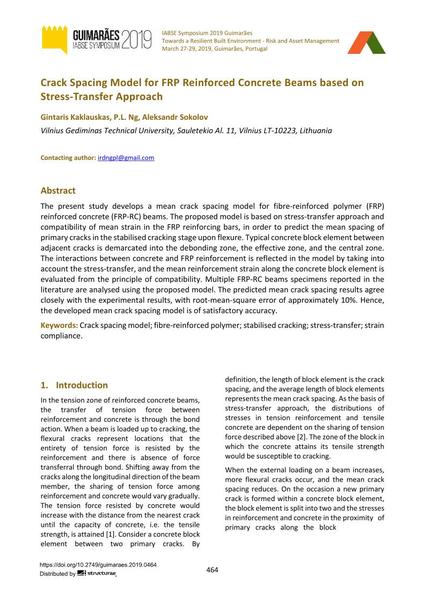Crack Spacing Model for FRP Reinforced Concrete Beams based on Stress-Transfer Approach

|
|
|||||||||||
Bibliografische Angaben
| Autor(en): |
Gintaris Kaklauskas
(Vilnius Gediminas Technical University, Sauletekio Al. 11, Vilnius LT-10223, Lithuania)
P. L. Ng (Vilnius Gediminas Technical University, Sauletekio Al. 11, Vilnius LT-10223, Lithuania) Aleksandr Sokolov (Vilnius Gediminas Technical University, Sauletekio Al. 11, Vilnius LT-10223, Lithuania) |
||||
|---|---|---|---|---|---|
| Medium: | Tagungsbeitrag | ||||
| Sprache(n): | Englisch | ||||
| Tagung: | IABSE Symposium: Towards a Resilient Built Environment Risk and Asset Management, Guimarães, Portugal, 27-29 March 2019 | ||||
| Veröffentlicht in: | IABSE Symposium Guimarães 2019 | ||||
|
|||||
| Seite(n): | 464-470 | ||||
| Anzahl der Seiten (im PDF): | 7 | ||||
| DOI: | 10.2749/guimaraes.2019.0464 | ||||
| Abstrakt: |
The present study develops a mean crack spacing model for fibre-reinforced polymer (FRP) reinforced concrete (FRP-RC) beams. The proposed model is based on stress-transfer approach and compatibility of mean strain in the FRP reinforcing bars, in order to predict the mean spacing of primary cracks in the stabilised cracking stage upon flexure. Typical concrete block element between adjacent cracks is demarcated into the debonding zone, the effective zone, and the central zone. The interactions between concrete and FRP reinforcement is reflected in the model by taking into account the stress-transfer, and the mean reinforcement strain along the concrete block element is evaluated from the principle of compatibility. Multiple FRP-RC beams specimens reported in the literature are analysed using the proposed model. The predicted mean crack spacing results agree closely with the experimental results, with root-mean-square error of approximately 10%. Hence, the developed mean crack spacing model is of satisfactory accuracy. |
||||
